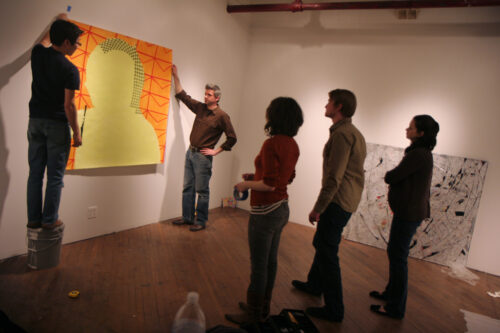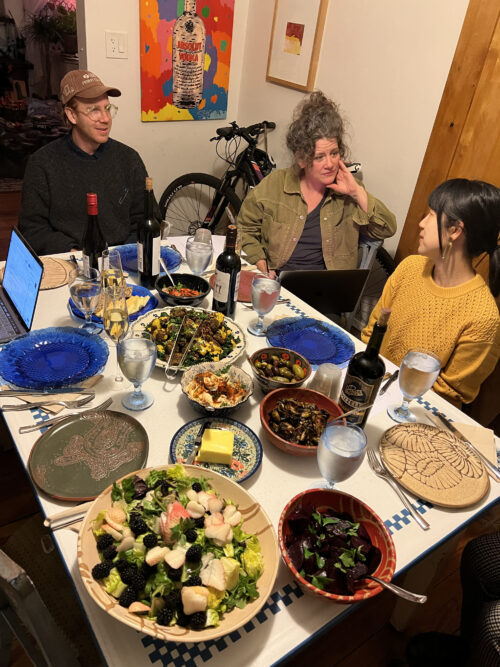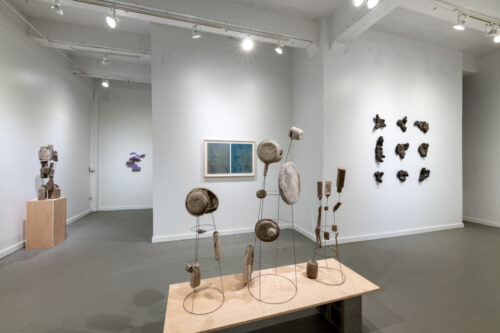Elizabeth Johnson: As I read the “about” statement on the TSA website, I thought of friend and founding member Rachael Gorchov, who lives and teaches in the Lehigh Valley. How are you dependent upon Director Alex Paik and Rachael, or other founding members? Do they continue to brainstorm, lead or steer projects?
Terri Saulin: Each space is run completely independently by the members. As a non-profit, TSA original founder, Alex Paik is the director/face of the overarching organization. He acts as treasurer for all the spaces. Alex is a wonder; his guidance is far reaching. He fundraises and organizes Diversity, Inclusion, Equity and Belonging (DIEB) reading groups and opportunities. The group is currently reading Social Change Now: A Guide For Reflection and Connection. Deepa Iyer will be leading our organization through a 90-minute workshop on her Social Change Map in June. Founding members retain institutional memory and guide new members to grow and care for the audiences of each space.
Elizabeth: Is each satellite in Philadelphia, New York, Los Angeles, Chicago, and Greenville considered a franchise of sorts? Does each receive funds or do independent fundraising? Is there an annual meeting? Do the different galleries stay in touch?
Terri: Since each space is run independently, sales of works go directly to each space responsible for the sale of work. Funds from grants for the organization are divided between individual spaces so that we can all stay afloat. We have some very generous repeat donors and a grant writer for the whole organization. TSA Philly meets every four to six weeks. We have regular directors’ meetings that encourage all members to sit in. We gather for special group and international projects. Feels Like the First Time was our first comprehensive, survey show of members from all the satellites that was hosted in Chicago in 2021.
Elizabeth: TSA Philly opened in 2009 and was the founding space. Did it change location since then? Who pays the rent? How many people come out for a typical opening? Do local art colleges or students use the gallery as a resource?

Terri: TSA Philadelphia first opened at 319 North 11th Street. It was a gritty and wonderful beginning, but there was a fire in the building in 2017. Our programming was scheduled so far in advance that an interruption would have been problematic to maintain momentum. We jumped at an opening at the Crane Arts, made the move, and love it here. Each member pays dues to make the rent, and some operational costs are supplemented by grant funding and our open call each year. Our last opening had 278 people. We are thrilled numbers are returning post COVID and thrilled to welcome the new Clay Studio as our neighbor! Many of our members, past members and friends are professors, and many visit with their classes. Students are introduced to the concept of artist-run spaces in addition to the exhibiting artists. The Crane itself is a great example of how entrepreneurial artists create space to continue working. Joining the community at the Crane is a kind “gym membership” for making.
Elizabeth: Is there a waiting list to become a member?
Terri: There is not a waiting list to become a new member, but we are currently interviewing for three or four new members. The way we gain new members fluctuates between putting out an open call or through member nominations. Our Annual Open Call attracts a huge number of artists that we think of as possible members. Philadelphia is an amazing cultural gem; we are fortunate and enriched by so many unique and deeply gifted artists. Our members need to live relatively close by since we staff the gallery ourselves. Each member pays dues and gets to curate an exhibit about every two years. We are thrilled to have just added new members Sierra Montoya Barela, Madhulika Lai, Henry Morales and Bryan Warner.

Elizabeth: How did you reach your audience during the Pandemic? How many people are on the mailing list or follow Instagram and other social media? Do you feel like the art world is reenergized in 2023?
Terri: During the pandemic, many of us participated in fundraising opportunities, donating artworks to places in need of funding. We created an Artist in Residence program for artists to use our space during the pandemic to create and document a body of work. Our mailing list is under 1,000, and we have roughly 5,525 followers on Instagram and 2,500 on Facebook. We went from trying to do a show a month to 8 shows a year. We learned that shorter exhibitions limited the number of visitors, the possibility of reviews and their effectiveness for inspiring others to visit. I feel like the art world is definitely re-energized with beautiful new spaces, and new life being breathed into old spaces.
Elizabeth: Could we discuss the artistic vision of TSA Philly? What kinds of art do you look for as curators? Is there such a thing as TSA taste? Is there a trick to blending, integrating or accommodating individual taste in your democratic process?
Terri: We are guided by our mission more than aesthetics. We strive to create opportunities. Many of us are teaching artists who are engaged in the local community, which creates a constant pool of choices. We have an open call that is designed to expand our scope. Those are curated by committees, and often groups and choices are driven by new relationships discovered between works submitted. Every member artist has more or less free reign over the shows that they curate, so if there is TSA taste, it has more to do with overlapping interests among our members than with group decisions.
Elizabeth: Can you tell me the story of the current show Here After? How did it unfold, from the first inkling of an idea, to sourcing the artists, focusing on the theme and installing the show? Does each person in your group have special roles?

https://www.tigerstrikesasteroid.com/tagged/hereafter
Megan Biddle: I have been a member at TSA since 2016, and Here After is the third show I’ve organized. Members generally alternate between solo and curatorial exhibitions during their tenure. This two-person show was somewhat of a hybrid: I had a new body of work I was excited to share and felt it would be more interesting in conversation with another artist’s work within the context of the Philadelphia scene. I met Erin [who?]last summer in Massachusetts and felt energized by her enthusiasm and curiosity about art and making, and knew I wanted to work with her. I recognized a similar affinity toward materials and process, and we are both passionate about growing things. Once we committed to the show, themes unfolded naturally through Zoom conversations, emails and source image swaps that solidified when we brought Leah Triplett Harrington in on the essay. Installing last week was a fulfilling experience and we worked together seamlessly. It’s fantastic to share this type of dynamic with a friend and fellow artist.
As for roles, the labor lands on the person putting on a show: logistics of transporting work, laying out the exhibition, install, lighting, writing press releases, image lists, consignment forms, setting up photography, printing the essay/takeaway, deinstall. There are other members putting eyes on things, but typically you’re in it alone. In this case I had a terrific collaborator who has been amazing to work with, but it’s a lot of work and many hats to wear on top of getting the work ready for the exhibition.
Elizabeth: As working artists, who may also need to make money from jobs, how much of your time every week goes into TSA work? Do you have an opinion considering the question: Do artists make good art critics?
Terri: I spend about 3-5 hours a week on TSA Philadelphia. Closer to a show opening or closing, when I am gathering info for the press release, doing mailings and posting on social media it is more like 12 hours a week. Teaching artists make great critics for sure. Most teachers have a solid background in art history. They are also guiding students to write about their own work and prepare thesis papers. In turn, they are also writing their own exhibition, grant and residency applications. They are always attending openings, looking at work and talking to other artists. Close inspection, listening and constant writing can be a recipe for a pretty good critic. I show in the gallery every couple of years when I feel I have an important and strong body of work to share. The years in between are used for curating.
Kara Mshinda: What I like about TSA is that the time commitment for each member may fluctuate throughout the year. Some of us are parents as well as working and teaching artists. Some of us travel for work. Some of us have chronic health conditions that may prohibit our participation at times. I’ve been a member since 2020 and there is an unspoken ethos of grace: “do what you can, when you can.”
As for artists making good critics, it depends ! I believe that some artists have a particular way of thinking, feeling, and seeing artwork. Some artists prefer certain styles or genres or media over others. Some rely on their expertise in their craft. Idiosyncrasies influence judgment and this can lead to narrow considerations of others’ artwork. As an artist, I aim to have an eclectic and informed palate of aesthetics. I fail at this sometimes! It’s important to return to an artwork multiple times and sit with it before offering a critique. There is no doubt that I have benefited greatly from other artists’ constructive critiques of my work.
Elizabeth: Judging by the website, and my own art reading, TSA–the brand–seems to be doing well getting press. Who handles press contacts and how do you keep your shows in play for getting reviews?
Terri: I have been the press coordinator since I started in 2010. It is a collaborative effort though. Sometimes the person who is coordinating the show takes it into their own hands to ask someone to write an essay. This kind of supplemental material often attracts the attention of other writers, as it makes for quick work. There are not really any major press outlets covering art in Philadelphia anymore. The Inquirer has spread coverage very thin, and there are not many [print] magazines or small papers doing reviews. It seems all the writing is done by arts organizations and other artists.
Elizabeth: As print coverage declines, the Philly Artblog and Title Magazine review as many exhibitions as current funding allows. Does anyone in TSA cultivate collectors?
Terri: No one is really working on cultivating collectors at TSA that I know of, but we all try to bring our individual audiences to each event.
Elizabeth: Looking in the rearview mirror, what has made some shows more successful than others? TSA seems to have always been inclusive, democratic and fair in spirit. Not seeming to rely on shock, a chief goal seems to present original ideas through vibrant work. Could we make a list of words that you connect with TSA Philly? that you hope is communicated through your programming?
Terri: I can’t pinpoint a recipe for shows that are more successful than others – aside from the fact that our members are all excellent artists that don’t phone it in. They care about the work that they make and about the programming that the gallery presents. Words are hard to commit to when I think of TSA, but “family” is certainly one of them, as well as “professional, thoughtful, approachable, inviting.” I have been with the organization for thirteen years. We have gone through a million structural changes. I can honestly say that I have made life-long, solid friendships with every person I have had the gift of working with. I’ve forged friendships with many of the artists and visitors as well.
Amy Lee Ketchum: Diversity.
Duwenavue Santé Johnson: I’d say we’re all problem solvers.
Kara: Collaborative. We work toward common goals.
Elizabeth: I imagine that artists join the group for a while and then leave after a few years. If the membership changes but the system pretty much stays the same, what has been tweaked in the overall structure in past years, in the hope of keeping the TSA brand going? Does Alex Paik express hope to continue for generations?
Terri: We have had dedicated directors and co-directors, but recently we have switched to a non-hierarchical structure where each member is responsible for a different set of tasks. At times, particularly if the project is far away, in another state or country, we have a point person or two that shoulders the heavy lifting, but we all really do weigh in on almost all the projects. The only time we really give over complete control is when we have a guest curator. An Exchange of Shifting Atmospheres is a fantastic collaboration going on now, curated by Leslie Moody Castro of Mexico City and former Philadelphia TSA member Ricky Yanas of ULISES books fame.
We have rules about gallery maintenance that are a risk at times, but mostly everyone is respectful and does a great job at curating and scheduling special events that go along with the programming. As far as tweaking the overall structure is concerned, we rely on an ever-evolving handbook for new members. It is getting to the point where MOST of our members are going to be new! We old heads have to step up our game and add to that TSA textbook to make sure the chemistry stays volatile and fizzing. I think “brand” isn’t really a great fit to describe the organization. If anything, I like to think of it as our name indicates, a kind of a space exploration with each space being a different satellite in our network, and the crew changes as folks move on. I don’t see our “starship admiral” Alex stopping anytime soon. I am also pretty sure, “de-commissioned” officers will return from time to time on an emeritus basis for special projects and anniversaries!
Elizabeth: Why did you decide to become non-hierarchical?
Terri: We chose to be non-hierarchical due to leadership burnout; all the members were at different stages, at that time. New members learning the system and older members wanting to transition out of their roles. No one wanted to take on so much individual responsibility, and as it turns out, it’s a fruitful and exciting challenge. We like to joke that people call us communists.
Elizabeth: I imagine that budgets vary for each exhibition. Can a member/curator ask for more funds for a more expensive but worthy show? Would they need to source the extra funds? Does the group seek to keep exhibition budgets close to the same amount?
Kara: Exhibition budgets are generally the same amount for each member/curator. Some supplies and materials may be reimbursed if it will be used for gallery purposes. If there is a special need that a member, artist, or curator needs we put our resources together to make it work. Very general example, say an artist needs an extra pedestal, sound device, or a special drill. If we don’t have it in the gallery, we look in our own studios or reach out to our connections and we lend them.
Elizabeth: Being a TSA member is hard, unpaid work. What have you gotten out of it as compensation?
Nichola Kinch: The payoff is not money, but opportunity. I was curated into a TSA show before I became a member. I stay for the community and international opportunities to exhibit that I would have never landed on my own. Galleries from cities around the world contact us to invite us to show.
Megan Biddle: I created work for a show in Berlin that used the large store front windows of the gallery for an installation. It was an interesting challenge with constraints around shipping concerning weight and scale. I ended up working with acetate to print large transparent drawings that were adhered to the glass windows, which is my primary medium.
Duwenavue Santé Johnson: In Nov 2022, I was invited as a TSA member and juror to help select the open call winners for Mirror Material with other TSA members from different cities. We were compensated for our time, which was a bonus, but overall, the reward for me was giving Bay Area artists a voice and a space to be featured at Southern Exposure.
Greyory Blake: I got a recent job through TSA contacts.
Terri: I had a nice review by Edith Newhall at The Philadelphia Inquirer and was featured in a show at The Museum for Art in Wood, as a result of being a member. I have also used TSA as a teaching tool, bringing students to shows and talking about artist run spaces. Members and exhibiting artists have been gracious enough to speak to students on many occasions.
Kara: I’ve grown personally and professionally as a result of being a member of TSA. My background is in Visual Anthropology, and I came into Fine Arts later in life. When I began my art practice, I figured some things out but lacked other tools of the trade. I’ve acquired more hands-on experience than many artists who’ve had formal art education. Being in an art collective like TSA aligns with my learning style, since I understand and learn by seeing and doing. I’ve learned about budgets, installation, building partnerships, promotion, descriptive writing, and curatorial processes. By being involved in TSA, I’ve made life-long friends and colleagues.









